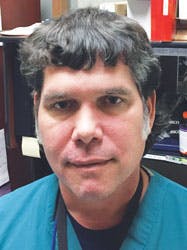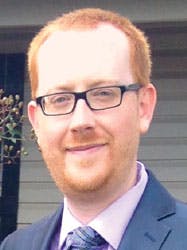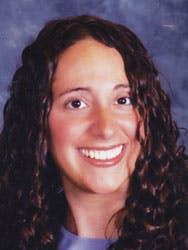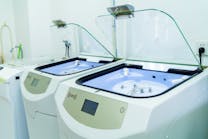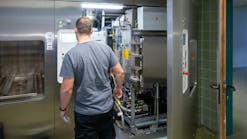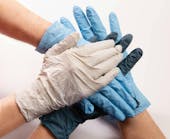The average annual salary for central sterile/sterile processing department (CS/SPD) professionals dropped slightly — down $1,269 from 2016 to 2017 — according to the results of the 2017 Healthcare Purchasing News CS/SPD Salary Survey. But over 60 percent of survey respondents reported an increase in pay.
- Lead Tech salaries surge/Educators plunge: The average annual salary for CS/SPD Lead Technicians rose $3,821, while salaries for Educators dropped $8,441. Last year, those in the Educator category showed an $8,714 average annual pay increase, so this year’s results perhaps reveal a natural correction in that category with the average Educator salary ($44,773) returning close to what it was reported to be in 2015.
- Modest increases for Supervisors, Directors and Managers: Survey results revealed the average annual pay increased by $3,609 for CS/SPD Supervisors, $2,385 for CS/SPD Directors and $1,861 for CS/SPD Managers in 2017.
- Salaries for CS/SPD Techs/Coordinators rise/Surgical Instrument Techs fall: Salaries for those in the CS/SPD Technician/Coordinator category rose $433/year on average since last year, while Surgical Instrument Technicians reported a $2,667 pay drop.
- Job security holds steady: The survey revealed 94 percent of CS/SPD professionals feel somewhat or very secure in their positions, and 22 percent expect a bonus in 2017.
“I love this profession and take great pride in what I do,” said Ann Marie Trybus, Certified Sterile Processing Technician, St. Joseph Mercy Hospital. “It’s an exhausting job, one that is physically and mentally demanding, and it pays very little. If I didn’t love it so much I would be doing something else because what I now make in CS/SPD is what I made at a retail store in 1990. The healthcare industry wants so much from us but most are not willing to give the matching rewards.”
Chuck DePreker is Operating Room/Sterile Processing Supply Chain Manager at Eisenhower Army Medical Center, and works part time in CS/SPD at another very busy hospital in the evenings. He states:
“I enjoy SPD work and take great pride in doing it well. I also like to teach and train. I have seen techs showing greater interest in becoming certified, becoming better problem solvers and following the regulatory agencies’ best practices guidelines. As far as what SPD techs are generally paid, unfortunately I have not seen a trend of better pay after all my years in this line of work. Most hospitals tend to pay on the low side and that sometimes keeps potentially talented prospects from applying, and the best and brightest go somewhere else.”
“The SPD is the heart of the hospital and impacts the efficiency and quality of care patients’ experience,” said March Konja, CRCST, CHL, SPD Director of Quality Improvement, SpecialtyCare. “Yet, salary ranges have long been an issue for attracting and retaining SPD techs, making it all too common that hospitals struggle to fill openings with experienced and certified techs.”
CS/SPD compensation: a “chicken or egg” challenge
Michael Matthews, Manager, Central Sterile, Baptist Health, and Weston “Hank” Balch, Director of Sterile Processing at University Health System, told HPN about an initiative they are spearheading to uncover the root causes of low salaries in the CS/SPD profession, and ways to address this and associated issues, such as job dissatisfaction and high turnover rates.
“There are a number of associated issues in the profession and not one silver bullet we can fire to fix everything,” said Matthews. “One major issue is that most hospital C-suite executives see sterile processing as a pure cost center. Next, nobody has quantified the value of a single, highly productive, highly qualified technician. There’s no number that says a bad tech costs your hospital $X and a good one saves your hospital $X. So combine the two and it’s clear why executives simply want to get sterile processing done as cheaply as possible.”
Balch questions: “In the midst of the current compensation model, how do we drive excellence? There are a number of like-minded people in this profession who have been contemplating this challenge and are working to develop a solution. It’s really a chicken or the egg sort of issue — do we pay everyone more and wait to see if the quality and service levels rise? Or can we demonstrate on the front end that those facilities investing in CS/SPD education, certification and other support have higher quality levels, increased productivity, and decreased turnover rates, and therefore operate under a true pay-for-performance model?”
In the meantime, Matthews and Balch convey the struggles that CS/SPD leaders face when trying to recruit and retain talented and dedicated technicians when salaries are low and job demands are high. While they are in CS/SPD leadership roles presently, both worked their way up the ranks of the profession’s career ladder and personally understand the challenges of being a technician.
“I’m a manager now, but I cut my teeth in this industry,” said Matthews. “I know what it’s like to make below the federal poverty limit. When I was a technician I was making $12/hour and working to support a wife and two kids. Those individuals who are ambitious and critical thinkers — the ones who have the potential to be really great techs – are not going to last in this profession if things stay the way they are. They’re going to find careers that compensate them better and value their skills – and you can’t blame them for it.”
CS/SPD professionals value certification — still on the rise
This year’s survey found 88 percent of respondents were certified, and an additional 10 percent are in the process of becoming certified or are considering it. Of those surveyed, 63 percent reported that their facilities require certification, up from 56 percent in 2016.
Josephine Colacci, Esq., Government Affairs Director for the International Association Of Healthcare Central Service Materiel Management (IAHCSMM), -provided HPN this update on currently legislative efforts around Central Service technician certification requirements.
Massachusetts
In 2017, IAHCSMM will be reintroducing legislation in Massachusetts. According to Colacci, the organization’s Massachusetts bill passed many hurdles during the two-year legislative session. The bill successfully passed out of the Joint Public Health Committee, the Joint Health Care Financing Committee, the Senate Rules Committee, the Senate, the House Steering, Policy, and Scheduling Committee, and was awaiting a final vote in the House of Representatives.
“The bill died on the calendar, which means it was never brought up for its final vote and due to the legislature running out of time the bill did not pass,” Colacci explains.
Pennsylvania
In Pennsylvania, IAHCSMM spent 2016 educating legislators about the Central Service profession and explaining the importance of its legislation. “As we start a new two-year legislative cycle, we are hoping to be slated for a committee hearing this year,” said Colacci.
Tennessee
IAHCSMM will be amending the Tennessee law regarding certification requirements for new Central Service technicians that was signed into law last year. Colacci notes that IAHCSMM was not consulted about the legislation in Tennessee while the bill was making its way through the legislative process.
“The language in the bill was not consistent with our legislation in other states,” said Colacci. “Therefore, several national associations reached out to us with concerns regarding the language in the law. We will be amending the law to address issues that IAHCSMM – along with other national associations – believe should be made.”
Thoughts on certification
“A few states require certification now but across the board we are seeing more and more hospitals outside of these states requiring certification as well,” continued Konja. “We believe certification is very important to this job and can drive change. Gaining certification and having to maintain it keeps you abreast of changes and challenges in technology and the profession.”
DePreker believes certification lends greater validity to the profession and provides valuable reinforcement training, stating:
“About half of us in my department are certified and we received a bonus for it, which was a good morale enhancer. There’s a sense of pride that comes with earning your CRCST, and it makes others realize they should become certified too.”
Matthews points out that without certification, there is no barrier to entry for the CS/SPD technician position — and without a barrier to entry, technicians will continue to be undervalued and underpaid.
“It’s shocking that only four states require certification, and that it’s so difficult to push one of those bills through,” said Matthews. “The reason why people don’t want to link certification to salary is because that’s the number one problem of getting those bills pushed through. Hospitals don’t want certification to be mandatory because that creates a barrier to entry, which increases the price. They will not agree to anything that increases costs, especially when the value hasn’t been quantified.”
Education builds skills — and boosts pay
As in previous years, the 2017 survey found higher salaries in CS/SPD are commensurate with higher levels of education. While those with high school degrees in the profession earn an average of $51,113 per year, those with bachelor’s degrees earn nearly $20,000 more — with an average annual salary of $70,185. CS/SPD professionals with post-graduate degrees earn the most, with an average salary of $72,368 in 2017.
“But education for people wanting to enter the CS/SPD profession is limited,” said Konja. “In order to address this SpecialtyCare developed its own training and certification prep program. This allows us identify individuals that may not have CS/SPD backgrounds, but have a strong work ethic and willingness to learn, and quickly get them up to speed on the critical skills and processes needed in this role.”
Konja and her team provide a classroom setting to help them prepare for the IAHCSMM certification course, as well as hands-on experience in the clinical setting.
While education for those entering the profession is limited, continuing education opportunities for CS/SPD are numerous — and professionals are taking advantage of them. Of those surveyed, 79 percent participate in 10 or more continuing education courses/lessons each year, with 30 percent participating in 20 or more.
“This is not a turnkey job — you have to get experience that can only be obtained by getting the right education and certifications,” said Jeremy Parroco, Central Sterile Consultant, Healthcare Surgical Instruments, Inc. “My advice to someone who wants to succeed in this profession is to keep the blinders on. You’ve got to keep focused and look forward and don’t worry what’s going on to the left or the right. You have to keep your goal in mind.”
Parroco, who has been in the CS/SPD profession for nearly 20 years, encourages technicians to actively seek out opportunities to grow and learn. He notes how education goes beyond the classroom and into the clinical setting, stating:
“Become familiar with every step of instrument processing. Observe surgeries when you can and see how the instruments you have processed are being used. If you ask someone in the OR if you can observe a surgery, they won’t say no — especially if you work in a teaching hospital. People are willing to teach and help you advance your skills — you just have to ask.”
DePreker, who began his career in the Army where he was cross-trained as an operating room (OR) surgical technician and a CS/SPD technician, believes there has been a fundamental shift in the minds of sterile processing professionals, with a growing number of technicians becoming more enlightened in their roles and realizing the importance of their positions.
“There are people who view sterile processing as a dead end job where you make minimum wage for the rest of your life and maybe get a $0.50 raise each year,” said DePreker. “But if you start off fresh and become competent and trained and really get yourself into this line of work and become smart — there is all sort of knowledge you can gain out there.”
“If you run up against a surgeon who wants you to go against your training then tell him/her that your job is to follow standard practices to not only protect the patient, but also protect that surgeon and the facility from any risk/liability that could arise out of patient injury,” he adds. “Remind them that they need someone like you on their side so they can sleep soundly at night knowing those instruments are safe.”
The CS/SPD career ladder — promoting a new generation of leaders
Many of the CS/SPD professionals interviewed for this article expressed frustration at healthcare organizations appointing individuals from outside of the profession to department leadership positions rather than promoting from within. According to Balch, a true challenge is that today’s CS/SPD leaders have not done an adequate job of preparing others within the industry to take over their positions.
“Succession planning is not a strong point in CS/SPD currently,” Balch says. “Long-term SPD leaders are retiring and there is not necessarily someone in their shadow ready to step up who has the credentials and hands-on mentorship they need to do the job. We’re in a position now where many facilities have to pull individuals out of the OR or materials management to lead the SPD, because there are no other qualified candidates.”
“I’ve seen many departments requiring someone with a nursing degree to manage the CS/SPD but in many cases these nurses don’t know sterile processing,” said Trybus. “They come in, don’t know what they are doing and those CS/SPD professionals in the department are angry because they would have liked that job. In this industry, we’ve got managers who have never touched a dirty instrument but are making huge dollars – there is a disparity there. Instead, hospitals should choose individuals who have done the job and want to do it.”
In his last position, Balch led a CS/SPD practical leadership training program that bridged the gap between technicians and leadership positions. The program taught technicians skills required to manage the department (e.g., budgeting, workflow, recruiting/hiring).
“One of the things I’m constantly telling my technicians is that arguing your case now to get a 5 percent raise is fine, but where you really start to see the pay increase is when you go from technician to manager or from supervisor to director,” said Balch. “To climb up the career ladder and significantly grow in compensation you have to grow your skills and experience through certification and continuing education. For sterile processing leaders in the industry, the burden is on us to empower and encourage those two conditions and communicate in a way that connects techs to the larger picture of career growth.”

Kara Nadeau | Senior Contributing Editor
Kara Nadeau is Sterile Processing Editor for Healthcare Purchasing News.



